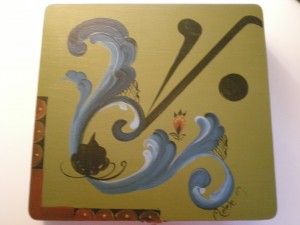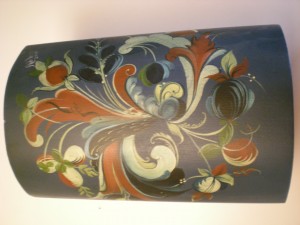Rosemaling:
My grandmother Adele is extremely passionate about her artwork. Her favorite thing to do is paint Rosemaling. The pictures above are examples of pieces that she has painted for me. The first is a box that she gave me for Christmas, which is considered contemporary. The box has some Rosemaling but she updated it and was able to adapt to my tastes. In this particular case she subtly added golf clubs to the design because golf is one of my favorite sports. The other is considered more traditional Rosemalling and that was given to me for my 16th birthday. She was largely inspired by images of Romsemalling like those found in Rosemalling: The Beautiful Norwegian Art.
My grandma told me that there are seven different kinds of Rosemaling. This is because the valleys were separated and each valley developed their own kinds. She is knowledgeable in all seven. She told me that authentic Rosemaling is done on wood. When she took the lessons, it was really a challenge. They were all male teachers and they were all from Norway.
The reason that she wanted to learn was to get back in touch with her Norwegian heritage. Her mother was from Hallingdal and her father was from Gudbransdal. Those two names are important because they are the names of the Rosemalling styles that originated from them. She told me that Nils Ellingsgard is one of the more famous Rosemallers to come out of Norway. He was recognized by the king and was whom she learned from. The book by him is very important to her because she was able to look at it and learn from it. She also told me that she was lucky enough to take lessons from him up in Seattle.
As far as Rosemaling itself goes, it is a very disciplined type of art to begin with. The Norwegians painted everything, even there ceilings when it snowed and they could not get out. The people of Norway are doing their best to perpetuate the art and keep it going. Both Norway and Norwegians want it to stay in circulation. It used to be done entirely by men but now anyone can do it and many women are taking up the practice my Grandmother said. She also told me that artists are now selling the patterns that she learned from. You kind of took from other peoples patterns to learn how to do it, she said. If you used some of them in your work, the contemporary Rosemallers use this phrase: The telemark design inspired by to give credit that they learned it from whomever. She said that it would be wrong to say that it was not inspired by someone else.
One thing that I found extremely interesting was that the people in Norway said that those painting in America were too disciplined, and wanted them to be more contemporary. There seems to be some discrepancy in this. This seems to be the case in most traditional practices that are maintained abroad from their origins. The ones doing it are much more traditional than the ones that live in the actual place. Norway has stated that those trying to learn the art are trying to be too authentic and not adapting it to their new cultural surroundings. They want the Rosemallers who are practicing abroad to be more liberal with their creations and not worry about being governed by the traditional forms of the art.
Annotations: Blanck, Helen Elizabeth. Rosemaling: The Beautiful Norwegian Art. Minneapolis: Woodland Park Fine Arts: 1974.


